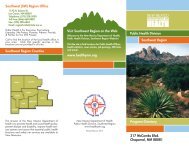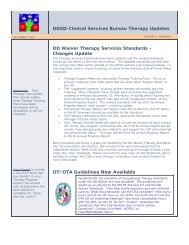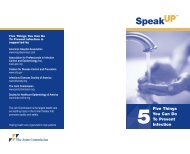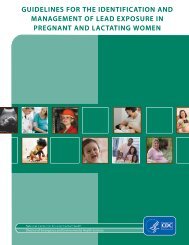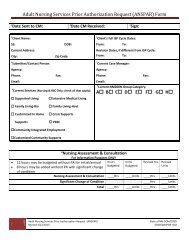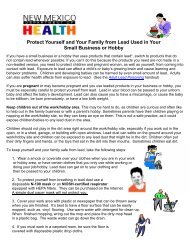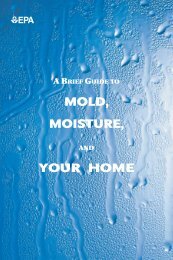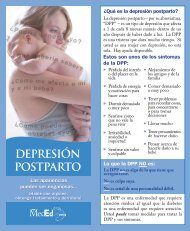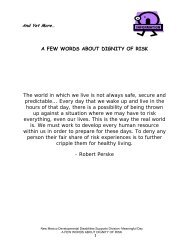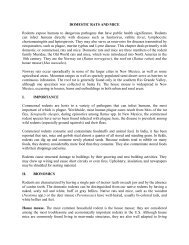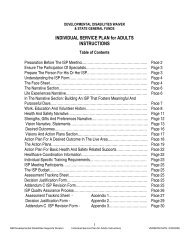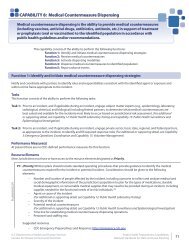INDIVIDUALIZED FAMILY SERVICE PLAN (IFSP)
INDIVIDUALIZED FAMILY SERVICE PLAN (IFSP)
INDIVIDUALIZED FAMILY SERVICE PLAN (IFSP)
You also want an ePaper? Increase the reach of your titles
YUMPU automatically turns print PDFs into web optimized ePapers that Google loves.
<strong>INDIVIDUALIZED</strong> <strong>FAMILY</strong> <strong>SERVICE</strong> <strong>PLAN</strong> (<strong>IFSP</strong>)Child’s Name: Female MaleDate of Birth: Referral Date: Referral from:Parent/Guardian Name:Relationship:Mailing Address:Parent/Guardian Name:Relationship:Mailing Address:Telephone:Telephone:Physical Address:County of Residence:Primary Language Spoken in Home:Ethnicity: Hispanic/Latino? Yes NoRace: American Indian/Alaskan Native – Tribe: _________________________________________ AsianBlack or African American Native Hawaiian or Other Pacific Islander WhiteHow was this information obtained?Parent or Family Identification (preferred method) Team Identification Combination of bothThis plan is (Check one) Interim <strong>IFSP</strong> Initial <strong>IFSP</strong> Annual <strong>IFSP</strong>Date of <strong>IFSP</strong> Meeting: <strong>IFSP</strong> Start Date: <strong>IFSP</strong> End Date:If Initial <strong>IFSP</strong> - was it held within 45 days of referral date? Yes NoIf no – what was the reason for exceeding the 45 days?• Anticipated Date for <strong>IFSP</strong> Review: • Anticipated Date for Annual <strong>IFSP</strong>:Designated Service Coordinator:Eligibility Determination Date:(Date CME team determined eligibility)(Service Coordinator’s Name, Agency)Date of Annual EligibilityRe-determination:(Phone Number)Current Eligibility for the FIT Program (check all that apply):Developmental Delay Established Condition Biological/Medical Risk Environmental RiskICD-9 Code 1: ICD-9 Code 2: ICD-9 Code 3:Exit Date:Exit to:NM FIT <strong>IFSP</strong> (Print Cover) Page of Rev. Aug. 2012
Child’s Name: Child’s DOB: <strong>IFSP</strong> DateOur Family Life (Part II)Our everyday routines, activities, places, and people in our lifeWho provides support to your family? This can include: family (e.g. grandparents, aunts, uncles), aswell as friends, groups / organizations (e.g. child care, WIC, parent groups, community or religiousgroups), and other people (e.g. baby sitter, doctor, nurse) How do these supports play a role in yourchild’s and family’s daily routines?(Teams should create a family eco-map with the child / family in the middle to illustrate thepeople/supports involved in the child’s life and the frequency / amount of support received e.g.Grandma – looks after Monica 4 afternoons a week).I choose NOT to share information about our everyday routines, activities & places. Parent Initials [ ]NM FIT <strong>IFSP</strong> (Our Family Life-Part II) Page of Rev. Aug. 2012
Child’s Name: Child’s DOB: <strong>IFSP</strong> DatePresent Abilities, Strengths, and NeedsA developmental evaluation/assessment was recently completed with your child and/or ongoing assessment information has beengathered. This information helps us understand your child’s developmental strengths, as well as some of the things that arechallenging for your child and may be affecting how he is able to participate in family and community activities. This is the placewhere we SUMMARIZE what we have discovered so that our plan fits well with your child’s developmental strengths and needs.Date of evaluation/assessment: Based on: Initial Evaluation Ongoing AssessmentAssessment Instruments Used:Child’s Chronological Age: months Child’s Corrected Age (if applicable): months(until child’s 2 nd birthday)Summary of Relevant Health Status (Including Vision and Hearing)Primary Care Provider Name:Phone:Address:Child’s Overall Health (physical, emotional, behavioral) May include well-child visit information,medical/developmental diagnosis, medications, specialists, temperament, other interventions, etc.Eating, Nutrition, Dental:Sleep:Vision: Date Tested Results/concerns:Tested by (doctor or agency)Hearing: Date Tested Results/concerns:Tested by (doctor or agency)NM FIT <strong>IFSP</strong> (PASN 1) Page of Rev. Aug. 2012
Child’s Name: Child’s DOB: <strong>IFSP</strong> DatePresent Abilities, Strengths, and NeedsSensory Motor, Gross and Fine Motor Skills (sitting,rolling, standing, crawling, walking, hand skills, sensory regulation)Areas where child does well.Developmental Level (from evaluation /assessment):Areas where child needs support.Communication Skills (preverbal, nonverbal, talking,understanding language, speech)Areas where child does well.Developmental Level (from evaluation /assessment):Areas where child needs support.Cognitive Skills (playing, thinking, problem solving)Developmental Level (from evaluation /assessment):Areas where child does well.Areas where child needs support.NM FIT <strong>IFSP</strong> (PASN 3) Page of Rev. Aug. 2012
Child’s Name: Child’s DOB: <strong>IFSP</strong> DatePresent Abilities, Strengths, and NeedsSocial and Emotional Skills (Self awareness, expressingand responding to feelings and interacting with others)Areas where child does well.Developmental Level (from evaluation /assessment):Areas where child needs support.Self-help or Adaptive Skills(self feeding, washing, toileting )Areas where child does well.Developmental Level (from evaluation /assessment):Areas where child needs support.NM FIT <strong>IFSP</strong> (PASN 3) Page of Rev. Aug. 2012
Child’s Name: Child’s DOB: <strong>IFSP</strong> DateChild / Family OutcomeOutcome #(What we want to see for our child/family as a result of early intervention supports and services).How will we know we’ve made progress?(Include the date, what the child/family will do, and how you will know it is happening. For example “Byhis first birthday (1/1/13) his parents report Johnny crawls on hands and knees from his bedroom to living room”)Our Strategies: (Who will do What in Which Everyday Routines, Activities and Places to meet thisoutcome?)* Note: Strategies should include: any assistive technology needed; activities that will occur in otherearly care & learning settings (as applicable); modeling and coaching activities; and consultation between teammembers.12345* Supports and services must be provided to your child in settings that are natural or typical for children of the same age (naturalenvironments). If, as a team we decide that we cannot achieve an outcome in a natural environment, we need to describe how wemade that decision and what we will do to move services and supports to natural environments as soon as possible.This outcome cannot be achieved by providing supports and services in natural environments because:We will work toward providing supports and services in natural environments to achieve this outcome by (describeplan and timeline):NM FIT <strong>IFSP</strong> (Outcomes) Page of Rev. Aug. 2012
Child’s Name: Child’s DOB: <strong>IFSP</strong> DateChild / Family OutcomeOutcome #(What we want to see for our child/family as a result of early intervention supports and services).How will we know we’ve made progress?(Include the date, what the child/family will do, and how you will know it is happening. For example “Byhis first birthday (1/1/13) his parents report Johnny crawls on hands and knees from his bedroom to living room”)Our Strategies: (Who will do What in Which Everyday Routines, Activities and Places to meet thisoutcome?)* Note: Strategies should include: any assistive technology needed; activities that will occur in otherearly care & learning settings (as applicable); modeling and coaching activities; and consultation between teammembers.12345* Supports and services must be provided to your child in settings that are natural or typical for children of the same age (naturalenvironments). If, as a team we decide that we cannot achieve an outcome in a natural environment, we need to describe how wemade that decision and what we will do to move services and supports to natural environments as soon as possible.This outcome cannot be achieved by providing supports and services in natural environments because:We will work toward providing supports and services in natural environments to achieve this outcome by (describeplan and timeline):NM FIT <strong>IFSP</strong> (Outcomes) Page of Rev. Aug. 2012
Child’s Name: Child’s DOB: <strong>IFSP</strong> DateChild / Family OutcomeOutcome #(What we want to see for our child/family as a result of early intervention supports and services).How will we know we’ve made progress?(Include the date, what the child/family will do, and how you will know it is happening. For example “Byhis first birthday (1/1/13) his parents report Johnny crawls on hands and knees from his bedroom to living room”)Our Strategies: (Who will do What in Which Everyday Routines, Activities and Places to meet thisoutcome?)* Note: Strategies should include: any assistive technology needed; activities that will occur in otherearly care & learning settings (as applicable); modeling and coaching activities; and consultation between teammembers.12345* Supports and services must be provided to your child in settings that are natural or typical for children of the same age (naturalenvironments). If, as a team we decide that we cannot achieve an outcome in a natural environment, we need to describe how wemade that decision and what we will do to move services and supports to natural environments as soon as possible.This outcome cannot be achieved by providing supports and services in natural environments because:We will work toward providing supports and services in natural environments to achieve this outcome by (describeplan and timeline):NM FIT <strong>IFSP</strong> (Outcomes) Page of Rev. Aug. 2012
Child’s Name: Child’s DOB: <strong>IFSP</strong> DateChild / Family OutcomeOutcome #(What we want to see for our child/family as a result of early intervention supports and services).How will we know we’ve made progress?(Include the date, what the child/family will do, and how you will know it is happening. For example “Byhis first birthday (1/1/13) his parents report Johnny crawls on hands and knees from his bedroom to living room”)Our Strategies: (Who will do What in Which Everyday Routines, Activities and Places to meet thisoutcome?)* Note: Strategies should include: any assistive technology needed; activities that will occur in otherearly care & learning settings (as applicable); modeling and coaching activities; and consultation between teammembers.12345* Supports and services must be provided to your child in settings that are natural or typical for children of the same age (naturalenvironments). If, as a team we decide that we cannot achieve an outcome in a natural environment, we need to describe how wemade that decision and what we will do to move services and supports to natural environments as soon as possible.This outcome cannot be achieved by providing supports and services in natural environments because:We will work toward providing supports and services in natural environments to achieve this outcome by (describeplan and timeline):NM FIT <strong>IFSP</strong> (Outcomes) Page of Rev. Aug. 2012
Child’s Name: Child’s DOB: <strong>IFSP</strong> DateTransition PlanMy child’s third birthday is:Transition Conference is required to be held by:(No later than 90 days prior to my child’s thirdbirthday)Referral form is required to be sent by:(At least 60 days prior to Transition Conference)Assessment Summary is required to be sent by:(At least 30 days prior to Transition Conference)Transition Conference invitation is required to besent by: (At least 30 days prior to TransitionConference)My child has been determined eligible for Part BSpecial Education*: Yes or No. Date:Where will Part B services be provided?*Transition will occur on:Transition Conference held on:Was this at least 90 days prior to the child’s thirdbirthday? Yes or NoIf no, please explain:Referral form sent:(Date sent to Part B)Assessment Summary sent :(Date sent to Part B)Transition Conference invitation sent:(Date sent to Part B)My child was not eligible for Part B, and istransitioning to:Transition Plan -Part 1 (Complete the following at the Initial <strong>IFSP</strong>):Date of initial <strong>IFSP</strong>We discussed transition timelines for our child and that our FSC will support our family through thetransition process, as our child approaches three years of age. We discussed the following:The current transition options including preschool and other early care and learning options in mycommunity are:Transition Plan - Part 2: (By the time the child is 24 months old the Transition plan shall beupdated)Date Part 2 Completedlisted below)(Enter either a projected date and /or date of completion for each transition processTransition Process Action Steps Who is responsible?Parents are informed ofall available earlychildhood transitionoptions in theircommunity.Parents have theopportunity to visitchildhood transitionoptions in theircommunity.FSC will provideinformation from theearly childhoodtransition partners.FSC will help facilitatethe opportunities to visitcommunity transitionoptions.Parent(s) and FSCParent(s) and FSCProjecteddate to becompletedDate ofcompletionNM FIT <strong>IFSP</strong> (Transition Plan) Page of Rev. Aug. 2012
Transition Process Action Steps Who is responsible?The parent(s) areinformed of their FIT(Part C) rights duringthe transition process.Referral form for theschool district will befilled out with parent(s)and FSC*(Referral form can alsobe sent to other earlychildhood providerswith parent consent).The TransitionConference date isscheduled with familyand transition partners(e.g. School district,Head Start, NMSBVI,NMSD, etc.)A written Invitation issent to the schooldistrict and transitionpartners.Prior Written Notice(PWN) form iscompleted for theTransition Conference.*Transition AssessmentSummary Form will becompleted with currentassessment information(“current” is defined aswithin 6 months of theTransition Conference)*FSC will make surefamily has copy of thefamily handbook andprocedural safeguards.FSC will send Referralform to school district atleast 60 days prior to theTransition Conference(and if possible 6 monthsprior to the child’s thirdbirthday).FSC scheduled TransitionConference to be heldon .(No later than 90 daysprior to the child’s thirdbirthday)FSC will send writteninvitation at least 30days prior to theTransition Conference.PWN will be given toparent(s) at least 5 daysprior to the scheduledTransition Conference.FSC, <strong>IFSP</strong> Team, and theparent(s) will fill out theTransition AssessmentSummary form and sendto the school district atleast 30 days prior to theTransition Conference.Parent(s) and FSCParent(s) and FSCParent(s); <strong>IFSP</strong> team; andthe following transitionpartners:FSCParent(s); FSC; <strong>IFSP</strong> team.School district confirmedreceipt on:Projecteddate to becompletedDate ofcompletionWe have gone over the transition options for my child. If eligible, I (we) would like my child to transitionto:We reviewed the following health information (including vision, hearing, and any other medical needs)related to my child’s transition:Other concerns or needs that need to be addressed in order to make this a smooth transition for our childand family:NM FIT <strong>IFSP</strong> (Transition Plan) Page of Rev. Aug. 2012
Transition Plan - Part 3 (To be completed at the Transition Conference – at least 90 days and not more than 9months before the child’s 3 rd birthday)Date Part 3 CompletedTransition ProcessUpdated information and/orassessment(s) are shared with parentpermission.Action StepsInformation to beshared includes:Who isresponsible?Parent(s); FSC;and FIT Program<strong>IFSP</strong> TeamProjecteddate to becompletedDate ofcompletionOther activities that need to occurbefore child transitions to support thechild and family (i.e., completingapplications, immunizations; schoolvisits, special considerations forms)Activities to becompleted:TransitionConferenceTeamSchool district gives a copy andexplains Part B Procedural Safeguardsto the family and requests consent forPart B initial evaluation in order for theschool district to determine Part Beligibility.Did the school districtexplain Part BProcedural Safeguardsto the familyYes or NoDid the school districtobtain consent for PartB initial evaluation?Yes or NoSchool district;Parent(s) andFIT Program<strong>IFSP</strong> Team.If no, next steps tocomplete this step areas follows:Discuss options for receiving services inthe least restrictive environment, suchas inclusive settings with typicallydeveloping children.School district staff andother early childrenshall discuss with theparent(s) inclusivepreschool options forthe child.Parent(s) andSchool districtand earlychildhoodpartners.Discuss FIT staff attending child’sIndividualized Education Program (IEP)meeting (if child is determined Part Beligible) if requested by the parent(s)School district willdiscuss with the familythe FIT staff’sparticipation at the IEPmeeting.Parent(s);School districtand earlychildhoodpartners.NM FIT <strong>IFSP</strong> (Transition Plan) Page of Rev. Aug. 2012
Transition ProcessAction StepsWho isresponsible?Projecteddate to becompletedDate ofcompletionFollow-up Service Coordination and/orfollow-up consultative services withthe preschool staff are offered to thefamily.Yes, our familywould like :No, our family hasdeclined post transitionservices.Parent(s), FSC,FIT team, andearly childhoodpartners.Date forfollow-uptransitionservices tobegin:They willend on:Other concerns or needs that need to be addressed in order to make this a smooth transition for our child andfamily:Our priorities and concerns were discussed during the transition processYes NoIf no, please explain:I / we participated fully in Part 3 of this transition plan as part of the Transition ConferenceParent/Guardian Signature:Parent/Guardian Signature:Date:Date:The following individuals also participated in this Transition Conference:Print Name(Role/disciplineLicensure/Certification)Signature DateMethod ofParticipationAgency/ContactInformationNM FIT <strong>IFSP</strong> (Transition Plan) Page of Rev. Aug. 2012
Child’s Name: Child’s DOB: <strong>IFSP</strong> DateSupports and Services Needed to Achieve OutcomesBelow are the supports and services decided upon by the <strong>IFSP</strong> team to achieve ALL Outcomes.<strong>IFSP</strong>Supports andServices( designatedtransdisciplinaryteam lead)Outcome #saddressedService type (Ongoing /Consult / E&A / follow-upSetting(See codes below)Method(Consultation / Group /Individual)Frequency(For example 1x, 2x)Period(Day/Week/Month/Quarter/Year etc.)Intensity(# of minutes)Provider(Name)Provider(Agency)StartDateEndDateFunding Source(See codes below)Family ServiceCoordinationTotal FIT hours per month (excluding FSC; Date hrs. Primary Location of Services (settingconsultation; E&A; respite and Medicaid SALUD Datehrs where >50% of service hours occur)and other funded services)*Datehrs*Submit a prior authorization request if over 14 hours[Note: Up to 12 hours per year of consultation between personnel may be provided for each of the above services]Service Codes: Setting Codes: Funding Source Codes:AT = Assistive TechnologyH= Home (may include some services outside M = Medicaid (fee-for-service)Aud = AudiologyDI = Developmental Instructionof the home)CBS = Community Based Setting (child care, DOH = Dept. of Health (State General Funds)FSC = Family Service CoordinationFTC&T = Family Therapy, Counseling & TrainingEarly Head Start, park, pool, etc.)DDP = Center based Developmental Delay O = Other (SALUD,WIC; Head Start; CYFD;HS = Health Service (to support EI services)MS = Medical Services (to support EI services)Program (< 50% typically developing children)IPL = Center based Inclusive ProviderOptum HealthNur = Nursing ServicesLocation (> 51% typically developing children)Nut = Nutrition ServicesOS = Other Setting in the communityOT = Occupational TherapyPT = Physical TherapyPsy = Psychological ServicesSLCL = Sign Language & Cued LanguageSW = Social Work ServicesSLP = Speech Language PathologyTrans = Transportation (to receive EI services)VS = Vision Services(hospital, clinic etc.)NM FIT <strong>IFSP</strong> (Supports & Services) Page of Rev. Aug. 2012
Child’s Name: Child’s DOB: <strong>IFSP</strong> DateIndividualized Family Service Plan – Signature PageThe following individuals have participated in the development of this ISFP and/or will assist in carrying it out.Note: The <strong>IFSP</strong> team must include parent(s)/guardian; service coordinator; person(s) directly involved in conducting the evaluations and assessment;others as requested by parents (family, friends, advocates); and personnel providing services to the child and family.Print Name(Role/disciplineLicensure/Certification)Signature DateMethod ofParticipationAgency/ContactInformationIn addition to the team members listed above, this <strong>IFSP</strong> should also be mailed* to:Primary Care Provider:Other:* Complete authorization to release formInformed Consent by Parents/GuardiansI have received a written copy of and verbal explanation of my rights in the FIT Programincluding the right to:Participate Confidentiality Submit a complaintAn evaluation Prior written notice of meetings Help to resolveGive consent Review your records DisagreementsA plan within 45 days Understand information (in native language)I participated fully in the development of this plan; andI give consent for this Individualized Family Service Plan (<strong>IFSP</strong>) to be carried out as written; orI do not accept this ISFP to be carried out as written however I do give consent for the followingservice(s) to begin:Parent/Guardian Signature:Parent/Guardian Signature:Date:Date:NM FIT <strong>IFSP</strong> (<strong>IFSP</strong> Signatures) Page of Rev. Aug. 2012
Child’s Name: Child’s DOB: <strong>IFSP</strong> DateDate of <strong>IFSP</strong> Review:Periodic Review of the <strong>IFSP</strong>A review of the <strong>IFSP</strong> must occur at least every six months. Revise the Child/Family Outcome page and theSupports and Services page if: 1) the strategies or services need to be changed; 2) an outcome is beingmodified; or 3) a new outcome is being added.Note: The periodic review of the <strong>IFSP</strong> must include the parent(s)/guardian and the service coordinator and others as appropriate.New Concerns/Significant EventsOutcome # Describe Progress Status (Check One)Team Member Signatures (Incl. Parents/Guardians)Outcome reachedContinue with outcomeRevise outcomeOutcome reachedContinue with outcomeRevise outcomeOutcome reachedContinue with outcomeRevise outcomeOutcome reachedContinue with outcomeRevise outcomeOutcome reachedContinue with outcomeRevise outcomePrint Name(Role/disciplineLicensure/Certification)Signature DateMethod ofParticipationAgency/ContactInformationNM FIT <strong>IFSP</strong> (Periodic Review) Page of Rev. Aug. 2012



